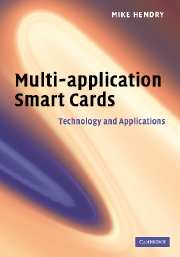Book contents
- Frontmatter
- Contents
- Foreword by Kevin Gillick
- Acknowledgements
- Part I Introduction
- Part II Technology
- Part III Business requirements
- 13 Common business requirements
- 14 Telecommunications
- 15 Banking
- 16 Transportation
- 17 Government and citizens' cards
- 18 Campus cards and closed user groups
- Part IV Implementation
- Appendix A Glossary
- Appendix B Further reading
- Appendix C Standards
- Index
- References
13 - Common business requirements
from Part III - Business requirements
Published online by Cambridge University Press: 11 August 2009
- Frontmatter
- Contents
- Foreword by Kevin Gillick
- Acknowledgements
- Part I Introduction
- Part II Technology
- Part III Business requirements
- 13 Common business requirements
- 14 Telecommunications
- 15 Banking
- 16 Transportation
- 17 Government and citizens' cards
- 18 Campus cards and closed user groups
- Part IV Implementation
- Appendix A Glossary
- Appendix B Further reading
- Appendix C Standards
- Index
- References
Summary
Having looked at the technology available to create a multi-application card scheme, we now turn to the business requirements – what are organisations trying to achieve when they launch a multi-application scheme? What are their underlying aims and how do these differ from sector to sector? If several parties are co-operating on a scheme and they each have different aims, this may cause problems from the start.
In this chapter, I will consider the requirements that are common to all multi-application schemes, and in the next five chapters I will look at some key sectors that have implemented smart-card schemes. In each case, there is scope for combining applications within one sector or across sectors: combinations within a sector may be difficult for reasons of competition or service scope, whereas across sectors the issues may be cultural or organisational. I will explore these in more detail in the last few chapters of the book.
Card issuing
Issuers generally have one of two motives for issuing a card: the first is to provide a simple record of entitlement (proof that some money has been paid or that a person may enter an office). This type of card is often short lived and it is probably a simple data carrier, adding little value. Typically, the requirement for such a card is to provide the record of entitlement at the lowest possible cost consistent with an adequate level of security and reliability. Such cards are very unlikely to carry multiple applications.
- Type
- Chapter
- Information
- Multi-application Smart CardsTechnology and Applications, pp. 119 - 128Publisher: Cambridge University PressPrint publication year: 2007



